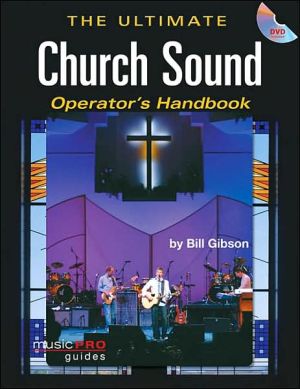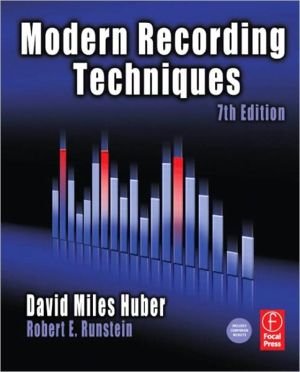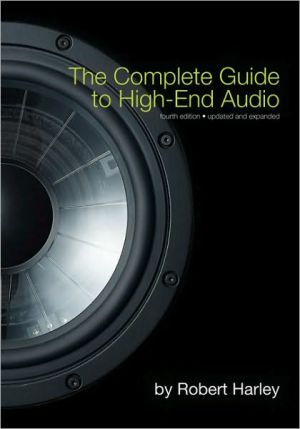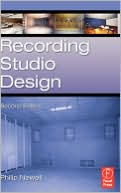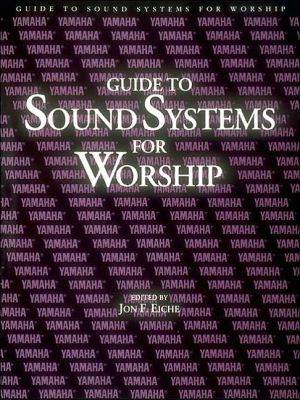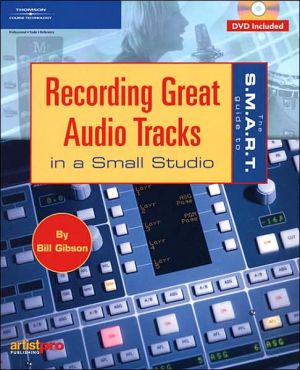The Ultimate Church Sound Operator's Handbook
This book and DVD are way more than just another manual for running a PA system! With almost two hours of video and audio instruction along with over 200 detailed illustrations, The Ultimate Church Sound Operator's Handbook is written to specifically address the concerns and needs of the sound person who serves ministries and churches. The modern church uses many of the same presentation tools that have become common in television, movies, recording studios, and concerts, placing a unique set...
Search in google:
The Ultimate Church Sound Operator's Handbook is written to specifically address the concerns and needs of the sound person who serves ministries and churches. The modern church uses many of the same presentation tools that have become common in television, movies, and concerts, placing a unique set of technical expectations on its eager, willing, and primarily volunteer force. This comprehensive handbook blends the relational and technical aspects of church sound in a straightforward and easy-to-understand manner. The Ultimate Church Sound Operator's Handbook will provide a leg-up to church sound operators who want to do a great job but need the perfect tool - created specifically for them - to gain the knowledge needed to excel and succeed.
Preface xxiThe Value in History xxiThe Road Is Narrow xxiiTerminology xxiiiQualifications for Being a Sound Operator 1List of Qualifications 2Listens to Music 2Loves Music 3Is a Proven Advocate of the Church, Pastor, Council, Organizational Structure, and Leadership 3Agrees with Church Theology 3Is a Church Member, Committed to the Church Mission and Vision 3Understands the Style and Spirit of Worship Music Desired by Church Leadership 4Is Servant-Hearted 4Has a Positive Outlook 4Does Not Have an Ego Problem 5Has a Consistent Spiritual Life 5Is Ministry-Minded 6Is a Lifelong Learner 7Is a Hard Worker 7Has a Long Attention Span 7Has a Stable Family Life 7Pursues Excellence 8Is Technically Gifted 8Has Good People Skills 8Has a Mature Perspective 9Likes to Help Others Succeed 10Does Not Participate in Gossip 10IsDetermined to Become an Excellent Sound Operator 10Summary 10Responsibilities of a Sound Operator 11Pray for the Worship Team 11Commit to Spiritual Development and Growth 12Get to Know the Team Leaders 12F+ind Out What the Music Director Expects 13Attend Rehearsals 13Attend Small Group Meetings 13Listen to Service Recordings 14Listen to Current Worship Music 14Be Punctual 15Learn the Songs 15Set Up Gear 16Strike Gear 16Develop Storage Systems 17Labeling Systems 17Snakes 19Storage Bins and Reels 19Mic Cases and Racks 20Storage Hooks and Racks 20Learn What a Good Mix Is 20Attend Seminars and Classes 20The Spiritual Importance of Worship and Music 21What Is Worship? 21The Authority of Excellence 22The Musicians to Battle before the Soldiers 23We Are Instructed throughout the Bible to Worship 24Take Your Duty Seriously 26Communicating the Heart and Word of God 26Prayer and the Sound Ministry 26Time, Just in Time 27Relational Considerations 29The Worship Service from the Minister's Viewpoint 29Introduce the Congregation to God 30Prepare the Congregation to Hear the Sermon 30Create a Unified Spiritual Tone among the Congregation 30Getting Along with Everyone 31Bending Over Backward 31Grace versus Judgment 31Keep Everything in Perspective 32An Atmosphere of Peace 32The Sound Operator/Pastor Relationship 33Be a Friend to the Pastor 33Ask Your Pastor's Opinion 33Be Understanding 33Be Open to Criticism 34Don't Offend Quickly 34Pastors Are People Too 35You Gotta Know When to Hold 'Em, Know When to Fold 'Em 35Communicate, Communicate, Communicate 35Ask Questions 36Keep Track of the Leaders' Opinions 36Conflicting Opinions and Who Wins 37Don't Avoid the Elephant in the Room 38Tone of Communication 38Reasons to Stand Up and Speak Your Mind 39Countering Blasphemy 39Defending the Pastor 40When the Pastor Doesn't Understand the Facts 40Don't Sweat the Small Stuff 40The Best Ways to Get Your Point Across 40Prayer 40Follow Protocol 41List Your Concerns or Joys 41The Worst Ways to Get Your Point Across 41Gossip 42Stirring the Pot 42Setting Up Camp 42Well...I'll Just Do It Anyway 43The E-Mail Bomb and Why You Should Avoid It 43Negative, Harsh, and Judgmental Attitude 44To Get Paid or Not to Get Paid 45The Volunteer Sound Operator 45It Doesn't Matter if You're Paid or Not 45Do Your Best 45Enjoy Being Part of Ministry 46Be Sensitive to Others 46Be Punctual 47The Quest for Excellence Shouldn't Change with Pay 47The Paid-Staff Sound Operator 48The Part-Time Gig 48Accountability 48Serving Multiple Ministries 49Training Ministry Leaders 50Building a Team 52Developing a Volunteer Crew 52Prayer and Share Time 53Special Functions 53Motivating and Assisting 54Job Descriptions 57Scheduling 58Volume Issues 61Pastoral Considerations 61Sound Operator Considerations 63Congregational Considerations 63Why Volume Issues Are So Common 64The Pastor versus the Music Director 65Agreement Is the Solution 65EQ versus Volume 66Painful Frequencies versus Comforting Frequencies 67Sound Reinforcement versus Music Presentation 67The Decibel Meter 67Who Is in Control? 68Can the Congregation Hear Themselves? 69Earning the Trust of the Team 69Multi-Generational Considerations 71Understanding Hearing Differences 71Types of Hearing Loss 72Presbycusis 72Tinnitus 73Conductive Hearing Loss 73Aural Hypersensitivity 73Hyperacusis 73Recruitment 74Education Is the Answer 74Senior Citizens (Born before 1946) 75Boomers (Born between 1946 and 1964) 75Generation X (Born between 1965 and 1980) 76Youth Groups 77Children 78Sound Theory 79Characteristics of Sound 79Speed 81Cycles 82Frequency 82Pitch 83Wavelength 83Amplitude 84Loudness 84Phase 87Harmonics, Overtones, and Partials 89Shape 92Envelope 93Attack 93Decay 94Sustain 94Release 94Interconnect Basics 95Speaker Cables 95Line-Level Cables 95Microphone Cables 96Some Cable Theory 96Balance of Amplitude 97Timing Considerations 97Do Cables Really Sound Different? 97Digital-Interconnect Cables 98Impedance 99Terminology 100Compatibility between Hi Z and Lo Z 100Balanced versus Unbalanced 102Terminology 102Unbalanced Guitar Cables 103Balanced Wiring 103Connectors 105RCA Connectors 105Quarter-Inch Phone Connectors 106XLR Connectors 107The Dual Banana Connector 107Speakon Connectors 108Plugging In 109Electrical Power 109Powering Up 109Powering Down 109Ground Hum 109Grounding 110Ground Loops 110Solutions to Grounding Problems 110Connect All Equipment to the Same Outlet 111Hire a Pro 111Auxiliary Power Supply 111Lifting the Ground 111Disconnect Shield at the Destination 112Circuit Tester 112Danger, Danger 112The Front-of-House Mixer 115Signal Path 115Input Levels 116Comparison of Three Different Versions of the Same Mix 117Input Stage 117Output Impedance 117The Preamp 118Attenuator 119Direct Box 120Passive versus Active DIs 121Meters 121Volume Unit (VU) 121Peak Program Meters (PPM) 122Adjusting Levels for Transients 122Phase 123Input Level Comparison 125Phantom Power 126Mic Level 126Line Level 126+4 dBm versus-10 dBV 127Channel Insert 128Effects Bus 128The Difference between a Live Mixer and a Recording Mixer 129Mutes 129Live 129Recording 129Outputs 130Live 130Recording 130Inputs 130Live 130Recording 130Solo Functions 131Live 131Recording 131Portability 131Live 131Recording 131Managing the Signal Path 131Input Faders 131Pre and Post 131Using the Aux Bus 132Group Assignment 133Summing 134Three Practical Applications for Splitting a Signal Using a Y 134Pan 135Gain Structure 135Unity Gain 135Potential Problems 136Solo 136PFL (Pre Fader Listen) 136AFL (After Fader Listen) 137Solo in Place/Mixdown Solo 137Mutes 137The Equalizer 137Frequency Selection (Hertz) 138Definition of Frequency Ranges 140Bandwidth 141Sweepable EQ 142Parametric EQ 143Graphic EQ 143Notch Filter 144Peaking Filters 144High-Pass Filter 144Low-Pass Filter 145Band-Pass Filter 145Shelving EQ 145Combined Equalizers 146The Equalizer's Sound 146Stereo Master 146Talkback/Communications 146Test Tones 147Console Layout 148Matrix 149Direct Outs 149The Analog Mixer versus the Digital Mixer 150FOH Mixer Position 150Mono Mix 150Stereo Mix 150Signal Processors 153Dynamics Processors 153Compressor 153To Compress or Not to Compress-That Is the Question 155Compression Parameters 155Threshold 155Attack Time 156Release Time 157Ratio 157Output Level 158The Difference between a Compressor and a Limiter 158Hard Knee versus Soft Knee Compression/Limiting 158Peak/RMS Detection 158Side Chain 159Meters on the Compressor/Limiter 160Input Level Meter 160Output Level Meter 161Gain Reduction Meter 161The Limiter 161Setup Suggestions for the Compressor/Limiter 162Effects Processors 163Wet versus Dry 163Patching Effects Devices 163Simple Delay Effects 163Slapback Delay 164Doubling/Tripling 165Modulation 166Phase Shifter 167Flanger 167Chorus 167Phase Reversal and Regeneration 167Stereo Effects 168Reverberation Effects 169Hall Reverb 170Chamber Reverb 170Plate Reverb 170Room Reverb 170Reverse Reverb 171Gated Reverb 171Other Variations of Reverberation 171Reverberation Effects Parameters 172Predelay 172Diffusion 172Decay Time 172Density 172Microphone Principles and Design 173Directional Characteristic 174Polar Response Graph 175On-Axis 175Off-Axis 175Sensitivity Scale 176Omnidirectional 176Bidirectional 177Unidirectional 177Cardioid 178Supercardioid 178Hypercardioid 178Ultracardioid 178Subcardioid 178Practical Applications 179Operating Principle 180Transducer Types 180Magnetic Induction Transducers 180Variable Capacitance Transducers 180Operating Principle of the Moving-Coil Mic 181Operating Principle of the Ribbon Mic 181Operating Principle of the Condenser Mic 182Phantom Power 184Electret Condenser Microphones 185Comparison between Moving-Coil, Ribbon, and Condenser Microphones 185Moving-Coil Mics 185Condenser Microphones 186Ribbon Mics 187The Shaping of the Pickup Pattern 188Physical Housing Design 188The Proximity Effect 190Compensating for the Proximity Effect 191Using the Proximity Effect to Our Advantage 191Response Characteristic 191Frequency Response Curve 191Transient Response 192Output Characteristic 192Equivalent Noise Rating/Self-Noise 192Sensitivity 193Maximum SPL Rating 193Impedance 194Stereo Mic Techniques 194Wireless Systems 199Components of the System 199Input Device 199Transmitter 199Receiver 200AM and FM Systems 200Amplitude Modulation 201Frequency Modulation 201VHF and UHF Systems 201Capture Effect 202Diversity 202Range 203Antenna Distribution Systems 204Batteries 204Diversity Indicator 205Squelch 206Microphones for Wireless Systems 206Lavaliere 206Headset 209Lectern 209Handheld 209Control Which Mic Is Turned On 209Two Mics 210Wireless Frequency Selection 210Mute Switch versus Power Switch 211Caring for the Antenna 211Adjusting Levels 212Connecting to the Sound System 212The Backup Plan 213Using the Wireless System 213Loudspeakers 215Commercially Built Cabinets 215Manufacturers 217Pro Audio Suppliers 218Crossover Configurations 218Passive Crossover 219Active Crossover 219Analog versus Digital Crossovers 220Full-Range Cabinets 220Two-Way Cabinets 220Three-Way Cabinets 221Four-Way Systems 222Powered Cabinets Pros and Cons 222Speaker Components 223Drivers 223Direct Radiating Cone Speakers 223Horn Compression Drivers 224The Importance of Enclosures 224Sealed Enclosures 225Infinite Baffle 225Acoustic Suspension 225Bass Reflex 225The Passive Radiator 226Transmission Line 226Component Alignment 226Speaker Impedance 228Calculating Speaker Impedance Loads 229The Racks 231Drive Rack 231Dynamics 232Compressor/Limiters 232Equalizers 233Real-Time Analyzers (RTA) 233Crossovers 235Delays 236The Amp Rack 237Peak Power 237RMS Power 237Continuous Power 237THD (Total Harmonic Distortion) 238IMD (Intermodulation Distortion) 238Speaker Sensitivity 238Power, SPL, and Sensitivity 239Correct Power Ratings for Each Cabinet 239Bridging a Stereo Amplifier 239Effects Rack 241Mic Preamplifiers 241Dynamics 242Compressor/Limiter 243Expander/Gates 244Effects 246Equalizers 247Music Playback Devices 247Recording Devices 248Patch Bays 248Intermittent Connections 249Loss of Signal Integrity 249Confusion for Inexperienced Operators 249Are They More Trouble Than They're Worth? 250Selecting the Appropriate Connection Format 250Quarter-Inch 250Tiny Telephone 250RCA 250Types of Patch Bay Connections 250Normalled 250Half Normalled-Bottom 251Half-Normalled-Top 251Full-Normalled 251Parallel 251De-Normalled, Non-Normalled, or Isolated 251What Goes into a Patch Bay 252Mixer Outputs 252Mixer Inputs 252Processor Inputs and Outputs 253Playback Device Outputs 253Tie Lines 253Recording Device Inputs and Outputs 253Planning and Laying Out an Efficient Bay 254Keeping it Neat 255Locking Various Components 255Lockout Devices 255The Box with No Knobs 256Basic Equipment Needs 247Generic Recommendations 257Professional Help 257Microphones 258Cables 258Direct Boxes 258Playback Devices 259Cases 259Small Church: Fewer Than 75 People 259Music versus Voice Reproduction 259Sound System Recommendation #1 259Mixer/Amp/Processor 260Speakers 260Sound System Recommendation #2 260Powered Mixers and Speakers 261Mackie 261Yamaha 261JBL 262Monitors 262Medium Church: Between 76 and 300 People 262Mixer 262Speakers 264Monitors 264Large Church: Between 301 and 1,000 People 265Professional Help 265Mixer 266Speakers 267Monitors 267Portable Systems 267Mega Church: More Than 1,000 People 268Professional Help 268Mixer 269Analog 269Digital 270Speakers 270Monitors 270Gymnasiums 270Youth Group 271Permanent System 271Portable System 271Evaluate Your Existing System 272Planning for Growth 272Growing the Plan 273Analysis Tools 273RTAs 273TEF Analysis 274Monitor Systems 275Feedback 275Directional Characteristic 276Mic Polar Response 276Monitor Connections 277Ringing Out the System 277The Procedure 278The Feedback Eliminator 278Singers Can Help 279Sing Close to the Mic 279Hand Over the Mic 279Hold the Body 279Don't Point 280Leaning Down to the Monitor 280More Mics Cause More Feedback Problems 280Floor Wedges 280Look behind the Group 280The Angle of Ascent 281Get Back, Jo Jo 281The Escalation of Desires 281To Wedge or Not to Wedge 282Dealing with Floor Monitor Leakage 282Side Fills 282Small-Format Monitors 283In-Ear Monitors 284Headphones 284Ear Buds 285ButtKicker 285Recommended In-Ear Systems 286Aux-Based Systems 286Channel-Based System 286Interface with FOH 287Direct Outputs 288System Hub Splits 289Splitter Snake 289Active versus Passive Split 289Aux Bus 290Monitor Mixer 291Getting Wireless 291Characteristics of a Good Monitor Mix 291Listen Up! 292Systems Design and Layout 293Mixer Placement 293Mono 293Stereo 294LCR 294Walk the Room 294Speaker Placement 295Front Line Boundary 295Critical Distance 295Coverage Pattern 296Connecting Multiple Speakers 297Time-Aligning Components 297Center Cluster 298Arrays 298Point Source Arrays 299Split-Point Source Arrays 299Zone Coverage 300Time Align 301Keep It Neat and Simple 301Bundles 301Digital Snakes 302Fine-Tuning the System 302Ear or Gear 302Voicing the System 303Analysis Methods and Devices 303The Sound Level Meter 303The Rack-Mounted Real-Time Analyzer 304The Software Real-Time Analyzer 306The Inadequacy of the RTA 308Documentation 308Three-Ring Binders 309Computer Documentation Files 309Build a Documentation System with a Plan 309Document All Connections and Settings 310Keeping Track of Gear 310Acoustic Considerations 311Dealing with Acoustics 311The Room 312Diffusion and Absorption 312Mode/Standing Wave/Resonance 313Calculating the Frequency of Standing Waves in a Room 314Axial Standing Waves 315Tangential Standing Waves 315Oblique Standing Waves 315Calculating Problematic Modes 315Consider All Opposing Surfaces 315Red Flags 316Flutter Echo 316Your Location in the Room Matters 317Everything Else in the Room Matters 318The Rectangle 318The Goal 318Solutions to Acoustical Problems 318Dimensional Proportions 318Adjusting Angles 319Concave Angles 319Convex Angles 320Treating Surfaces 320Absorption Coefficient (Absorbers) 320Diffusers 321The Ceiling 321Corners 322The Bass Trap 322Power Alley 323Using Your Knowledge of Acoustics 324New Construction 324Miking the Group 325Electric Guitar 325Guitar Fundamentals 326Tone and Timbre 326Pickup Placement 326Tone Controls 327Frequency Content 328Running Direct into the Mixer 328Miking the Speaker 328Mic Techniques 330Electric Guitar Levels 330Pickups 330Pickup Position 331Pickup Types 331Single-Coil 332Double-Coil Humbucking 332Active Pickups 332Equalizing the Guitar 332Delay 333Electronic Doubling 334Chorus/Flanger/Phase Shifter 334Reverberation 335Bass Guitar 335Direct Box/Direct In (DI) 336Pickup Output Level 336Plucking Styles 337Levels for Bass 338Compressing the Electric Bass 338Equalization of the Bass Guitar 340Panning the Bass 341Drums and Percussion 342Drum Conditioning 342Tuning 342Drumsticks 342Muffling Drums 343Hardware 343Room Acoustics 344Theories of Drum Miking 344Essential Microphones 344Mic Choices 344Positioning the Microphones 345Phase Interaction between Mics 345Drum Levels 345Isolating the Acoustic Drum Kit 346Miking a Drum Set with One Microphone 346Miking a Kit with Two Mics 347Miking a Kit with Three Mics 348Miking a Kit with Four Mics 349Close-Mike Technique 349Equalizing Drums 350Kick Drum 351Snare Drum 353Miking Toms 354Overhead Microphones 354The Hi-Hat Mic 355Gating the Drum Tracks 355Aiming the Mics 356Click Track 356Effects on Drums 357Compressing Drums 357Panning the Drums 357Miking Piano 358Mic Choice and Technique 359Stereo or Mono 361Instrument Maintenance 361Additional Mic Techniques 361Piano Levels 362Equalizing the Piano 364Compressing the Piano 364Reverberation 365Miking Vocals 365Mic Choice 365Moving-Coil (Dynamic) Mics 366Ribbon Mics 366Condenser Mics 366Mic Technique 367Proximity Effect 367The Timid 368The Bold 368The Outrageous Ham 368The Seasoned Singer 369Holding the Mic 369Wind Screen 369Hygiene 370The Proximity Effect 370Bass Roll-Off 371Dynamic Range 371Compressor/Limiter/Gate/Expander 371Backing Vocals 372Choir 372Mic Choice and Technique 372Ratio of Mics to Singers 373Positioning Choir Mics 374Cardioid Polar Pattern 374Pitch, Tone, Enunciation, and Blend 375Monitors 375Controlling the Band 376Monitor Content 376Monitor Position 376Synthesized Sounds 377Panning the Synth 377Equalization and Effects 377Acoustic Guitar 377Strings 378Picks 378Alternate Tunings 378The Impact of Different Wood Configurations on Tone 379Electric Acoustic Guitars 379Mic Techniques 380Dynamic Processing and the Acoustic Guitar 381Sound Check 383Setup Routine 383Power On/Power Off 383Labeling and Storage 384Walls and Boxes 384Build a System and Stick to It 385Training the Crew 385Zero the Board 386Documentation of the Mix 386Mark the Board 386...and Then There's Digital 387Decide on the Mixer Layout and Subgroupings 387Verify Functionality of All Equipment 388Feedback 389Performer Sound Check 389Ensure Functionality 389Refine Settings 389Perfection 390Fine-Tune the Monitor Mix 390The Difference between What They Want and What They Need 390Invite the Musicians to the Board 390Start without Monitors 390Communication with the Performers 391Built-in Talkback Mic 391External Talkback Mic 391Basic Troubleshooting 392Creating an Excellent Mix 395Structuring the Arrangement 395How to Structure an Effective Band Arrangement 396Arrangement Format 1 396Arrangement Format 2 396Ideally 397Creating Size in a Small Room 398Controlling the Mix in a Large Room 398The Sermon 399Intelligibility 399Headset Microphone 399Lavaliere Microphone 399Lectern Microphone 400Handheld Microphone 400Volume 401Compression 401Riding the Level 401Body Packs On or Off 402Watch the Wireless Mic Status 403Building the Mix 404The Decibel Meter and the Mix 404The Difference between Rehearsal and the Event 404First Things First 405Subtractive versus Additive Mixing 406Mixing Techniques for Rhythm Section and Voice 407Equalization: The Cumulative Effect 407Combining EQ 407Allocating EQ across the Audible Spectrum 408Learning from the Recording Engineer's Bag of Tricks 408Fitting the Puzzle Together: Consciously Combining EQ 410Sweeping a Peak to Find a Problem 410Basic Procedures for Building the Mix 411Electronic Drums 411Stock versus Custom Patches 411Phones and the FOH 412Equalization and Effects 413Kick and Snare Drums 413Pan the Cymbals for a Natural Sound 413Acoustic Drums 414Kick Drum 414Sweet Spot 414Mids 415Highs 415Complement Bass Guitar 415Snare Drum 415Toms 416Drum Set Overheads (Live) 416Bass Guitar 417Mixing Guitars 417Acoustic Guitar 417Running Direct 418Dynamic Control 418EQ 418Effects 418Electric Guitar 418Creating a Huge Sound 419Mixing Keyboards 420Piano 420Synth and Pad Effects 421Mixing the Lead Vocal 421Compression 422Expander 422Vocal EQ 422Simple Delay 423Add Backing Vocals 423Compressing the Group 423Panning 424Reverberation 425Combining Wet and Dry 425Delay 425Mixing the Event: Focus, Focus, Focus! 425Blending the Drums and Bass 426Blending Electric Guitars 427Blending Acoustic Guitars 427Blending the Mix 427Index 429
